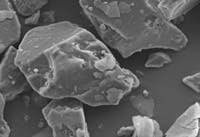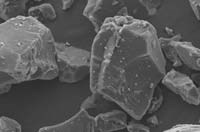Making the World a Brighter Place
Continued developments in powder materials and powder application techniques offer coaters a wide variety of metallic finishes…
From cars to office furniture—and of course consumer electronics such as computers, stereos, televisions, cell phones and DVD players—the metallic look is hot, and its popularity continues to grow. Manufacturers of more commercial and consumer products every day are choosing gold, silver and bronze looking finishes to enhance and accentuate their product in the marketplace. Some believe that this trend started in the US automotive industry. With the trend now at a global level, a recent survey indicated that silver is apparently the most popular color for cars and trucks in Asia, Europe and North America. So, the obvious question is whether metallic finishes are just the latest trend, or have they become yet another option in the wide variety of colors offered by today’s paint manufacturers? Although the production of metallic pigments has been around for some time—with substantial developmental work already taken place in the printer ink and liquid paint industries—many powder paint manufacturers see the trend not only continuing, but getting stronger, and continue to add various gold, silver and bronze-like powders to their already wide selection of colors.
It’s in the Pigment!
Metallic pigments are flake shaped particles consisting primarily of either aluminum for a silver-like appearance, copper or brass for a gold-like effect, mica for a pearl or satin- type appearance, and finally zinc, used more so for its corrosion resistance. The metallic “effect” is achieved through the interaction of different individual characteristics, consisting primarily of:
- Particle size and shape
- Leafing or non-leafing behavior of the pigment
In order to achieve a metallic-like luster, light is reflected onto the coated surface of the substrate. The amount of light reflected from the surface is proportional to the diameter of the metal pigment. Particle shape also plays an important role in reflecting light and creating a lustrous effect. For example, relatively thin particles can create a more mirror-like effect because they are thin and can lay down, so to speak, in a more level orientation relative to the surface of the substrate.
Another important parameter contributing to the optical effect of the metallic pigment is its leafing or non-leafing properties. This characteristic is determined by the pigment’s ability to “float.” Pigments that float better tend to distribute themselves more evenly over the surface of the film. Therefore, they are said to have more of a “leafing” effect. The disadvantage here, since they are located near the surface of the film, is that they can be marred, abraded, or easily oxidized. Powders that use leafing pigments typically require a secondary powder clear coat. On the other hand, non-leafing pigments tend not to float and therefore distribute more evenly within the thickness of the film. Powders using these types of pigments typically have much greater abrasion resistance and can be used without the need for a secondary (clear) coating. Since leafing and non-leafing pigments behave differently, they provide a different look. For example, specific to leafing and non-leafing aluminum pigments, non-leafing aluminum pigments will distribute themselves more evenly throughout the thickness of the film, therefore providing a more “sparkle-like” finish. On the other hand, since leafing aluminum pigments will distribute themselves more evenly across the surface of the film, they will provide a more chrome-like or “plated” finish. Now that we know the difference between leafing and non-leafing pigments, we need to further understand how these pigments are used within the different powder material manufacturing processes: bonded, blended and extrusion.
Metallic Material Processes—From Pigment to Powder
Extrusion. The pigment is blended with other raw materials of the formulation and extruded, followed by grinding. This process tends to homogeneously encapsulate the metal particle into the powder coating. Powders processed this way can be applied with both corona and tribo guns, have little “picture frame” effect, good penetration into recesses and provide uniform recycleability. In general, the color of the powder from this process tends to be darker or gray and does not provide a bright finish. Note that the metallic pigments are embedded within the resin particles. (See Figure 1)
Dry Blended. This method involves mixing the formulated powder coating with dry metal flakes under low shear conditions. The challenges associated with this method are the “picture framing” effect, color consistency, limited penetration in recessed areas, and limited recycleability. Powders processed this way are applied primarily using a corona gun with a flat spray nozzle. Note that many of the larger metallic particles are free. (See Figure 2)
Bonded. The metallic flakes are physically bonded to the surface of the powder coating. Ideally, all of the metallic particles are attached and do not separate during the application process, but in practice, some of the metallic particles are not firmly attached, which can cause various problems. In general, the particle size of the bonded metallic powder has fewer fines than dry blended powders, more consistent recycleability, more consistent color after recycling, less picture frame effect, less spitting and build up, better penetration into recesses, and a higher transfer efficiency. Although the powder can be reclaimed, it is best to minimize the ratio of reclaim to virgin powder. Only a few of the metallic particles are not bonded here as compared with the blended metallic powder. (See Figure 3)
Application—Various Equipment and System Considerations
Guns. Electrode air wash should be used on the spray guns to minimize build-up of powder on the electrode.
- Gun purge is used to blow powder out of the gun periodically to minimize powder build-up in the gun’s powder path. Depending on the powder and the application, guns should be purged every 1/2 - 1 hour. In extreme situations, guns are purged between the parts. Pumps and hoses should be purged preferably every four hours (during lunch break) and at least every eight hours.
- The gun-to-part distance should be at least 10 inches (250 mm). A larger gun to part distance (12-14 inches) (305-355 mm) will help provide a more consistent coverage.
- Reducing the atomizing air as much as possible will minimize segregation.
- The KV needs to be maximized to keep the powder from falling off the part. However, if the KV is too high, this will increase the electrostatic separation between the metallic pigment and the powder base, requiring the KV to be reduced. Reduced KV is obtained either manually by turning the KV down or by using automatic feedback control. For example, KV can be reduced to between -80 to -45 KV (typically, -65 KV is used).
- Automatic feedback control can also be used by setting the current to 10-15 µA.
- Some coaters use ion collectors to reduce the current draw to the part. This will reduce picture framing and provide a more consistent color. However, the ion collector may change the color and appearance of the finished part because of the difference in metallic flake orientation.
Nozzles. Flat spray nozzles are easier to maintain than conical deflectors that can collect particles and release them inadvertently onto the part. The flat spray nozzle also tends to shield the electrode and softens the electrostatic effect resulting in better lay down.
Hoppers. A mechanical agitator for the fluid bed may be necessary if the dry blend is difficult to fluidize consistently. Avoid using a vibratory box feeder, since the metallic particles tend to segregate to the bottom.
Powder Tubing. Some hose materials work better than others depending on the powder’s potential to tribocharge inside the hose and the hose’s ability to dissipate or neutralize the resulting charge. In most applications, a separate, dedicated powder hose is used for the metallic powder to eliminate any chance for cross-contamination with other powders in the hose.
Powder Recycling. Some customers recycle the dry blended powder. Maintaining a consistent color is the biggest issue here. For powder that is difficult to recycle, it may be possible to blend in up to about 10% of reclaim into the virgin powder without a noticeable change in color, depending on the application requirements. Even if the powder can be recycled, as when using bonded powders, care must to taken to use the lowest reclaim-to-virgin ratio possible.
Filters. Primary filters with fewer pleats that are considered to be more surface type filters (typically made of either polyester fibers or polyester/cellulose blend) are necessary to handle the metallic pigments to minimize premature clogging of the filter.
Operation. The key to a consistent quality coating is to maintain consistency during operation and to avoid the introduction of any variables. For example:
- Avoid changing equipment or equipment settings in the middle of a production run.
- All equipment as well as the workpiece should be properly grounded at all times.
- When coating manually, always use a gentle spray technique and avoid using a swirl or figure eight motion.
- Although recommendations for adding reclaim material to virgin differ anywhere from 10 - 30%, it is important to never introduce a partial supply (box) of virgin powder into the system due to separation caused by settling. Always introduce the full box.
- When both sides of a part must be coated, the most visible side should always be coated last to avoid any “framing” due to wrapping of the powder from one side to the other.
-
Strive to always maintain consistent film build since inconsistencies will likely cause variations in either color and/or effect.
Other Considerations
Metallic powders contain various types of metals, depending on the desired appearance. Common metals used in powder coatings consist of aluminum, copper, zinc, and copper/zinc alloys, depending on the desired color and properties desired. In general, dry blended metallic powders with a high metallic content of 5-6% are the most difficult to apply. The individual components can vary in particle shape, particle size, density, and composition—and therefore, chargeability and aerodynamics. Because of the variation in properties, when these components are dry blended, separation between the metal pigment and the powder base can occur during storage, transport, fluidization, and application. Separation can also occur in the recovery system leading to a difference in how the powder base and metallic pigment is applied, which can result in color shifts on the part over time depending on the amount of metallic pigment recovered. Recovery of the metallic pigments and powder base may be difficult to control. Agglomeration of the metallic pigments in the system means that metallic particles on the electrode can build up, leading to “spitting” on the part, “picture frame” effect on the part, and possible short circuits in the hose and spray gun because of possible plating out (internally coated with metallic particles). These effects may or may not occur depending on the specific properties of the formulation. Most of these issues can also apply to mica or other special effects pigments, since they too can be dry blended or bonded.
Summary
As the demand for metallic powders continues to grow, it is important to understand the current technology as well as stay abreast of the latest developments in application techniques, pigments, and powder material processes. The application and recovery of metallic powders can sometimes be challenging. The better understanding you have relative to pigments, powder materials, and maintaining consistent application/equipment settings, the less concern you should have with the final finished product.
Read Next
Education Bringing Cleaning to Machining
Debuting new speakers and cleaning technology content during this half-day workshop co-located with IMTS 2024.
Read MoreDelivering Increased Benefits to Greenhouse Films
Baystar's Borstar technology is helping customers deliver better, more reliable production methods to greenhouse agriculture.
Read MoreA ‘Clean’ Agenda Offers Unique Presentations in Chicago
The 2024 Parts Cleaning Conference, co-located with the International Manufacturing Technology Show, includes presentations by several speakers who are new to the conference and topics that have not been covered in past editions of this event.
Read More


















.jpg;maxWidth=300;quality=90)






